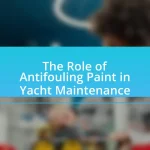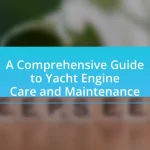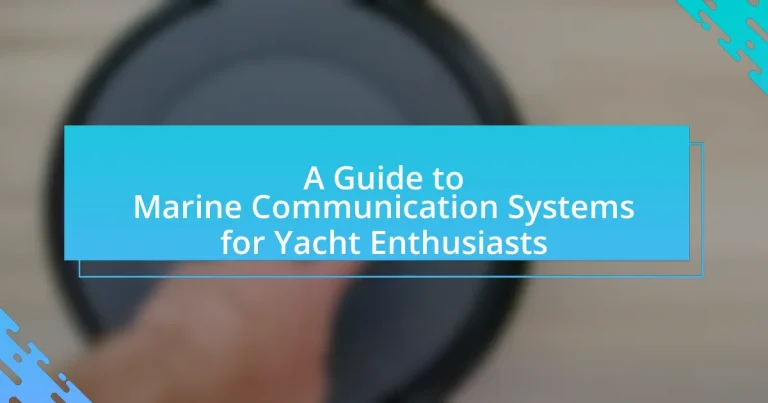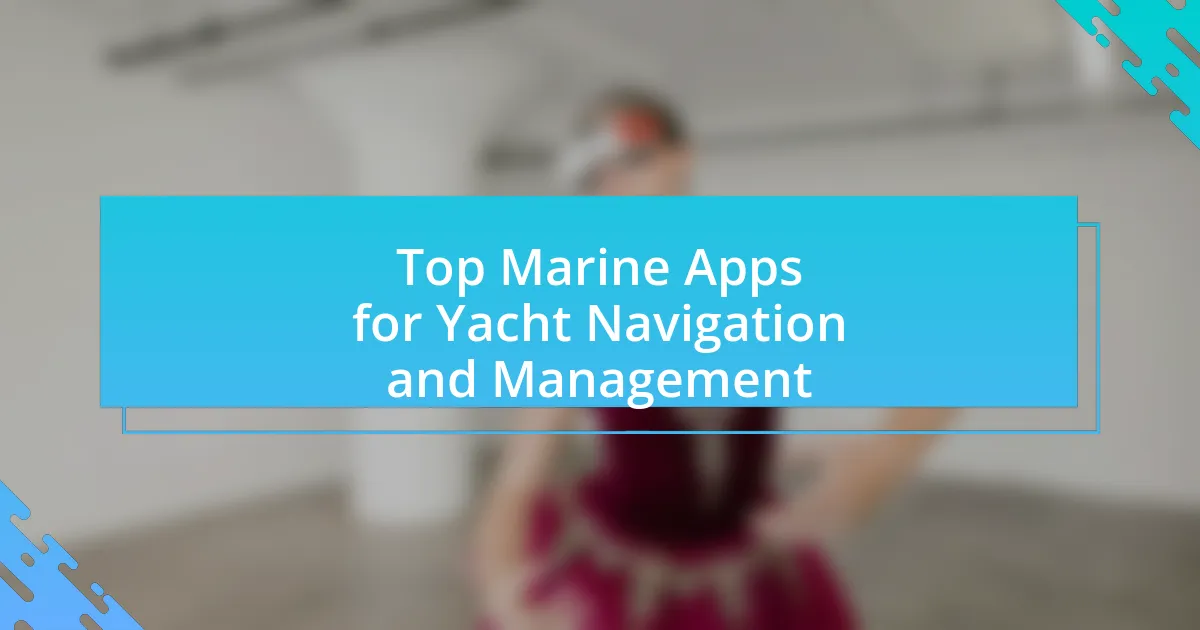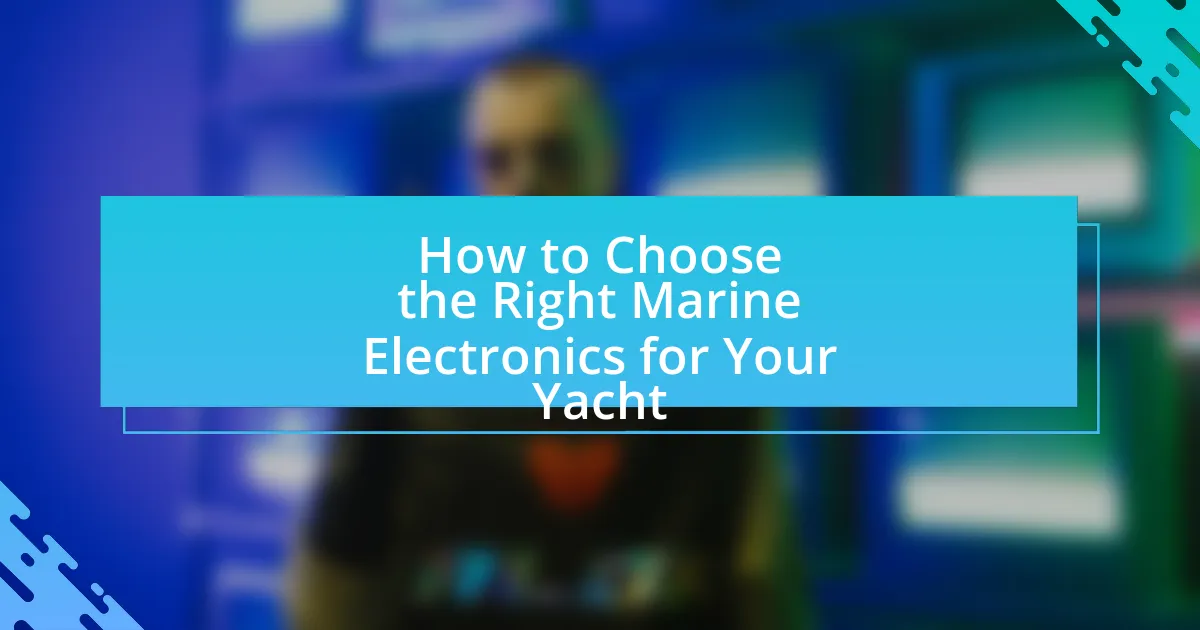Marine Communication Systems are essential technologies and equipment that facilitate communication between vessels and shore facilities, crucial for safety and navigation in maritime environments. This guide provides an overview of various marine communication systems, including VHF radios, satellite communication devices, and Automatic Identification Systems (AIS), detailing their functions, key components, and interactions. It emphasizes the importance of these systems for yacht enthusiasts, highlighting their role in enhancing safety, navigation, and connectivity while at sea. Additionally, the article covers best practices for effective use, maintenance tips, and resources for staying updated on advancements in marine communication technology.

What are Marine Communication Systems?
Marine Communication Systems are technologies and equipment used for communication between vessels and between vessels and shore facilities. These systems include VHF radios, satellite communication devices, and AIS (Automatic Identification System), which enhance safety and navigation by enabling real-time information exchange. For instance, VHF radios operate on specific frequencies to facilitate voice communication over short distances, while satellite systems provide global coverage for data transmission, ensuring that vessels remain connected even in remote areas. The integration of these technologies is crucial for effective maritime operations, as they help in avoiding collisions, coordinating rescue operations, and providing weather updates.
How do Marine Communication Systems function?
Marine communication systems function by utilizing various technologies to facilitate communication between vessels and shore stations. These systems typically include radio frequencies, satellite communications, and digital data transmission methods. For instance, VHF radios operate on specific frequencies to enable voice communication over short distances, while satellite systems provide global coverage for both voice and data transmission. Additionally, Automatic Identification Systems (AIS) enhance situational awareness by allowing vessels to share their position and navigation information with one another. The effectiveness of these systems is supported by international regulations, such as those established by the International Maritime Organization (IMO), which mandate the use of certain communication technologies for safety and navigation purposes.
What are the key components of Marine Communication Systems?
The key components of Marine Communication Systems include VHF radios, satellite communication systems, AIS (Automatic Identification System), EPIRBs (Emergency Position Indicating Radio Beacons), and intercom systems. VHF radios facilitate ship-to-ship and ship-to-shore communication, operating on designated marine frequencies. Satellite communication systems provide global coverage for voice and data transmission, essential for remote areas. AIS enhances maritime safety by allowing vessels to share their position and course information. EPIRBs are crucial for emergency situations, transmitting distress signals to rescue services. Intercom systems enable internal communication among crew members on board. These components collectively ensure effective communication and safety in marine environments.
How do these components interact in a marine environment?
Marine communication systems interact through a combination of technologies that facilitate information exchange among vessels and between vessels and shore stations. These systems, including VHF radios, AIS (Automatic Identification System), and satellite communication, work together to enhance safety, navigation, and operational efficiency. For instance, VHF radios allow for direct voice communication, while AIS provides real-time tracking of vessel positions, enabling mariners to avoid collisions. Satellite communication extends this capability beyond coastal areas, ensuring connectivity even in remote waters. The integration of these components is crucial for effective maritime operations, as evidenced by the International Maritime Organization’s regulations that mandate the use of certain communication technologies for safety at sea.
Why are Marine Communication Systems essential for yacht enthusiasts?
Marine Communication Systems are essential for yacht enthusiasts because they ensure safety, facilitate navigation, and enable effective communication with other vessels and shore services. These systems, such as VHF radios and satellite communication devices, provide critical information about weather conditions, navigational hazards, and emergency situations. For instance, the U.S. Coast Guard emphasizes the importance of VHF radios for distress signaling, which can significantly increase the chances of rescue during emergencies. Additionally, reliable communication systems allow yacht enthusiasts to coordinate with marinas and other boats, enhancing the overall sailing experience and ensuring compliance with maritime regulations.
What safety benefits do Marine Communication Systems provide?
Marine Communication Systems enhance safety by facilitating real-time communication between vessels and shore stations, which is crucial for navigation and emergency response. These systems, such as VHF radios and satellite communication, allow for immediate reporting of hazards, distress signals, and coordination during emergencies. For instance, the Global Maritime Distress and Safety System (GMDSS) ensures that vessels can send distress alerts and receive assistance promptly, significantly reducing response times in critical situations. Additionally, the use of Automatic Identification Systems (AIS) improves situational awareness by providing information on nearby vessels, helping to prevent collisions.
How do these systems enhance navigation and connectivity?
Marine communication systems enhance navigation and connectivity by providing real-time data exchange and reliable communication channels. These systems, such as GPS, AIS, and VHF radios, enable yacht enthusiasts to accurately determine their position, track other vessels, and communicate with shore stations or other boats. For instance, GPS technology allows for precise location tracking, while AIS (Automatic Identification System) improves situational awareness by displaying the positions and movements of nearby vessels. Furthermore, VHF radios facilitate direct communication, which is crucial for safety and coordination in busy marine environments. Collectively, these technologies significantly improve navigational accuracy and connectivity, ensuring safer and more efficient maritime travel.

What types of Marine Communication Systems are available?
Various types of Marine Communication Systems are available, including VHF radios, satellite communication systems, AIS (Automatic Identification System), and EPIRBs (Emergency Position Indicating Radio Beacons). VHF radios are essential for ship-to-ship and ship-to-shore communication, operating on designated marine frequencies. Satellite communication systems provide global coverage for voice and data transmission, crucial for remote areas. AIS enhances maritime safety by allowing vessels to share their position and movement data with each other. EPIRBs are vital for emergency situations, transmitting distress signals to search and rescue services. These systems collectively ensure effective communication and safety in marine environments.
What are the main categories of Marine Communication Systems?
The main categories of Marine Communication Systems include VHF Radio, Satellite Communication, and AIS (Automatic Identification System). VHF Radio is widely used for ship-to-ship and ship-to-shore communication, operating in the Very High Frequency band, which is essential for safety and coordination at sea. Satellite Communication provides global coverage, allowing vessels to communicate beyond the range of terrestrial systems, which is crucial for long-distance voyages. AIS enhances maritime safety by enabling vessels to share their position and movement data with others, facilitating navigation and collision avoidance. These categories are fundamental for effective communication in marine environments.
How do VHF radios differ from satellite communication systems?
VHF radios primarily operate within the Very High Frequency range (30 MHz to 300 MHz) and are designed for short-range communication, typically up to 20-30 nautical miles, depending on the power output and antenna height. In contrast, satellite communication systems utilize satellites in orbit to facilitate long-range communication, allowing users to connect globally regardless of their location. VHF radios rely on line-of-sight transmission, making them effective for local communication among vessels, while satellite systems can transmit signals through the atmosphere, overcoming geographical barriers. This distinction is crucial for yacht enthusiasts, as VHF radios are essential for immediate maritime communication, whereas satellite systems provide broader coverage for emergencies and remote areas.
What role do AIS and EPIRB play in marine communication?
AIS (Automatic Identification System) and EPIRB (Emergency Position Indicating Radio Beacon) are critical components of marine communication. AIS enhances situational awareness by allowing vessels to automatically exchange information such as position, course, and speed, thereby improving navigation safety and collision avoidance. EPIRB serves as a distress signaling device that transmits a distress signal to search and rescue satellites, enabling rapid location of vessels in emergencies. The effectiveness of AIS is evidenced by its mandatory use on larger vessels, which has significantly reduced maritime accidents. EPIRB has proven its value in numerous rescue operations, with statistics showing that it has been instrumental in saving lives at sea by facilitating timely responses from rescue services.
What features should yacht enthusiasts look for in Marine Communication Systems?
Yacht enthusiasts should look for reliability, range, ease of use, and integration capabilities in Marine Communication Systems. Reliability ensures consistent performance in various weather conditions, while range is crucial for effective communication over long distances, especially in remote areas. Ease of use allows for quick operation during emergencies, and integration capabilities enable seamless connectivity with other onboard systems, such as GPS and navigation tools. These features are essential for safety and efficient communication while at sea.
How does range and clarity impact communication effectiveness?
Range and clarity significantly impact communication effectiveness by determining how well messages are transmitted and understood in marine environments. Effective communication relies on the ability to convey information over distances (range) and the precision of that information (clarity). For instance, in marine communication systems, such as VHF radios, a greater range allows for communication over longer distances, which is crucial for safety and coordination at sea. Clarity ensures that messages are easily understood, reducing the risk of miscommunication that can lead to dangerous situations. Studies show that clear communication can improve response times and decision-making in critical scenarios, highlighting the importance of both range and clarity in ensuring effective communication among yacht enthusiasts.
What additional functionalities can enhance user experience?
Additional functionalities that can enhance user experience in marine communication systems include real-time weather updates, integrated navigation tools, and emergency alert systems. Real-time weather updates provide critical information that helps yacht enthusiasts make informed decisions while at sea, reducing risks associated with sudden weather changes. Integrated navigation tools, such as GPS and chart plotting, streamline route planning and enhance safety by providing accurate positioning. Emergency alert systems, which can automatically notify authorities in case of distress, significantly improve safety measures on board. These functionalities collectively contribute to a more efficient, safe, and enjoyable experience for yacht enthusiasts.
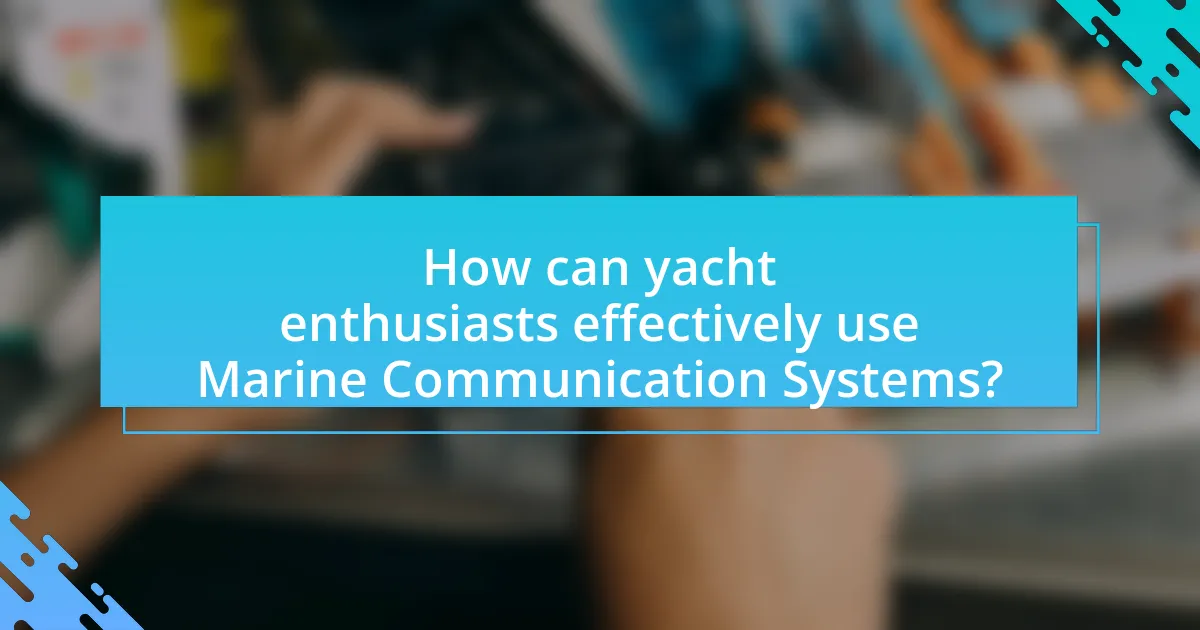
How can yacht enthusiasts effectively use Marine Communication Systems?
Yacht enthusiasts can effectively use Marine Communication Systems by utilizing VHF radios for reliable voice communication, AIS for tracking other vessels, and satellite communication for global coverage. VHF radios are essential for real-time communication with other boats and shore stations, operating on designated channels for safety and coordination. AIS, or Automatic Identification System, enhances situational awareness by providing information about nearby vessels, including their speed and direction, which is crucial for navigation and collision avoidance. Satellite communication systems, such as Iridium or Inmarsat, ensure connectivity even in remote areas where terrestrial networks are unavailable, allowing for emergency communication and weather updates. These systems collectively enhance safety, navigation, and overall enjoyment while yachting.
What best practices should be followed for using Marine Communication Systems?
Best practices for using Marine Communication Systems include ensuring proper equipment maintenance, utilizing redundancy in communication methods, and adhering to established protocols. Regular maintenance of communication devices, such as VHF radios and satellite systems, is crucial for reliability, as equipment failure can lead to dangerous situations at sea. Employing multiple communication methods, like VHF, SSB, and satellite phones, provides backup options in case one system fails, enhancing safety. Following established communication protocols, such as the Global Maritime Distress and Safety System (GMDSS), ensures effective communication during emergencies, as these protocols are designed to facilitate timely and clear exchanges of information.
How can regular maintenance improve system reliability?
Regular maintenance enhances system reliability by ensuring that all components function optimally and reducing the likelihood of failures. Consistent checks and servicing can identify wear and tear, allowing for timely repairs or replacements, which directly prevents unexpected breakdowns. For instance, a study by the National Institute of Standards and Technology found that regular maintenance can reduce equipment failure rates by up to 30%. This proactive approach not only extends the lifespan of marine communication systems but also ensures that they operate effectively when needed, thereby increasing overall reliability.
What are common troubleshooting tips for Marine Communication Systems?
Common troubleshooting tips for Marine Communication Systems include checking power sources, verifying connections, and ensuring proper antenna alignment. First, inspect the power supply to confirm that the system is receiving adequate voltage; many communication failures stem from low or interrupted power. Next, examine all connections for corrosion or looseness, as these can disrupt signal transmission. Additionally, ensure that antennas are correctly positioned and free from obstructions, as misalignment can significantly degrade performance. Regular software updates and firmware checks are also essential, as outdated systems may encounter compatibility issues. These steps are crucial for maintaining reliable communication in marine environments.
How can yacht enthusiasts stay updated on Marine Communication technology?
Yacht enthusiasts can stay updated on Marine Communication technology by subscribing to industry publications and online forums dedicated to marine technology. These resources often provide the latest news, product reviews, and advancements in communication systems. For instance, publications like “Marine Electronics Journal” and websites such as “Yachting World” frequently cover new technologies and trends in marine communication. Additionally, attending boat shows and marine technology expos allows enthusiasts to interact with manufacturers and learn about the latest innovations firsthand. Engaging with online communities on platforms like Facebook or Reddit can also facilitate discussions and information sharing among fellow yacht enthusiasts.
What resources are available for learning about new advancements?
Online courses, webinars, and industry publications are key resources for learning about new advancements in marine communication systems. Websites like Coursera and Udemy offer courses specifically focused on marine technology, while webinars hosted by organizations such as the National Marine Electronics Association provide insights into the latest trends and innovations. Additionally, industry publications like “Marine Electronics Journal” and “Yachting Magazine” regularly feature articles on advancements in communication systems, ensuring enthusiasts stay informed about the latest technologies and best practices.
How can networking with other yacht enthusiasts enhance knowledge sharing?
Networking with other yacht enthusiasts enhances knowledge sharing by facilitating the exchange of experiences, tips, and best practices related to marine communication systems. Engaging with a community of like-minded individuals allows yacht owners and operators to discuss specific technologies, troubleshoot issues, and share insights on effective communication strategies. For instance, a study by the International Council of Marine Industry Associations highlights that peer-to-peer interactions significantly improve understanding of complex systems, leading to better decision-making and increased safety on the water. This collaborative environment fosters continuous learning and adaptation, ultimately enriching the collective knowledge base of yacht enthusiasts.

